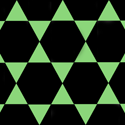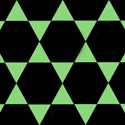Do frustrated magnets go critical?
In antiferromagnets, neighboring spins prefer to anti-align. However, in a triangular lattice it is impossible to anti-align all neighbors, giving rise to what is called “geometric frustration.” A particularly well-studied example of frustrated magnetism is the spin- Heisenberg antiferromagnetic model on a lattice of corner sharing triangles called kagome, after a Japanese style of basket weaving. Frustrated magnets have strong exchange interactions but are believed to have no long-range magnetic ordering, raising the possibility of novel magnetic states. In reality there were no good examples of spin- kagome antiferromagnets until recent studies showed that the mineral herbertsmithite (OH) Cl was an excellent realization. No magnetic order has been found experimentally in this system down to , but the exact ground state of herbertsmithite is not known.
In a paper published in Physical Review Letters, Joel Helton and colleagues at the Massachusetts Institute of Technology and the National Institute of Standards and Technology, Gaithersburg, with collaborators at the University of Maryland, all in the US, perform a scaling analysis for the magnetic response in herbertsmithite to elucidate its low-energy behavior. Using inelastic neutron scattering, Helton et al. find that the low-energy dynamic susceptibility displays an unusual scaling that is purely thermal over a wide range of temperature, energy, and applied magnetic field. Similar behavior has been observed in heavy-fermion superconductors and quantum antiferromagnets near a quantum critical point, suggesting that the kagome system is near a quantum critical point, or that the ground state of (OH) Cl could be a quantum critical spin liquid. – Daniel Ucko





